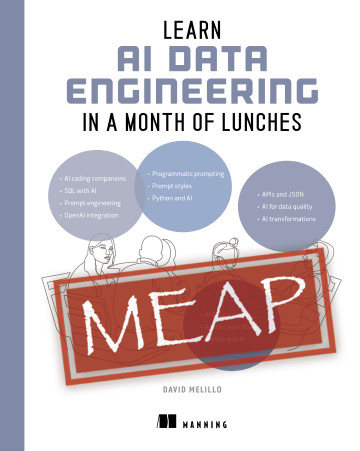Overview
1 Before You Begin
Artificial intelligence is presented as a defining technological shift comparable to the internet and cloud eras, succeeding where earlier AI attempts faltered thanks to scalable models, abundant data, and practical applications. The chapter frames current tensions—creative disruption, educational integrity, and changing developer workflows—while taking a clear stance: AI augments rather than replaces human intelligence. It argues that the most effective professionals will be those who integrate AI to remove drudgery and elevate work that requires creativity, judgment, and problem-solving, including the emerging role of agentic systems.
Within data engineering, AI matters because it allows practitioners to spend less time on repetitive infrastructure and more on business logic, insight, and impact. As a coding companion, AI can scaffold pipelines, generate and review code, debug, and standardize unstructured inputs—hinting at unified, language-driven workflows that compress many specialized tools into one interface. The chapter situates data engineers alongside analysts and data scientists, showing how AI accelerates SQL generation, feature engineering, EDA, anomaly detection, and data quality, and concludes that AI should be treated as a multi-tool for rapid development, automation, and clearer decisions about where humans add the most value.
The book targets data engineers, analysts, data scientists, and AI builders who want to move beyond ad hoc prompts to programmatic, scalable workflows for ingestion, transformation, enrichment, and governance. It surveys everyday AI uses and highlights data engineering applications such as cleansing, structured extraction from unstructured sources, synthetic data generation, NLP tasks, and policy enforcement, while briefly orienting readers to the evolving landscape of major LLM providers. Structured in a “Month of Lunches” format with hands-on labs, setup guides, and a practical environment (including SQL and Python tooling with AI integration), the chapter sets expectations for an accessible, step-by-step journey that equips readers to harness AI confidently and responsibly.
Being Immediately Effective with AI and Data Engineering
This book is about practical application. While many books dive deep into LLM architectures and AI theory, this book is about making you effective immediately.
By the end of the first few chapters, you’ll be using AI to generate and validate SQL queries, clean and transform datasets, extract insights from unstructured data, automate feature engineering, and integrate AI into your data pipelines. This book is designed to be hands-on, applied, and immediately useful. Let’s get started!
FAQ
What is the core message of “Before You Begin” about AI’s role?
AI is presented as an enhancer of human intelligence, not a replacement. The chapter emphasizes using AI to eliminate drudgery so professionals can focus on creativity, critical thinking, and problem-solving, even as agentic systems continue to evolve.Why does AI matter specifically to data engineering?
AI offloads repetitive and abstract infrastructure work, allowing data engineers to move closer to the business. This means spending more time on logic, insight, and direct value delivery through data products rather than on configuration and ops.How can AI help a data engineer day-to-day?
AI acts as a coding companion that generates and refines code, scaffolds pipelines, and provides natural language interfaces to libraries like pandas, NumPy, and scikit-learn. It can also review prompts, debug, compare implementation options, and convert unstructured inputs into structured data.How does AI assist data analysts and data scientists?
For analysts, AI translates plain English to SQL, automates routine analysis, and accelerates dashboarding while flagging anomalies. For data scientists, it suggests features, speeds EDA, summarizes trends, prototypes models, and helps refine hypotheses.Who is this book for, and what prerequisites help?
This book is for data engineers, analysts, data scientists, and AI enthusiasts who want to go beyond simple prompts and IDE autocompletion to build programmatic AI-powered data workflows. Familiarity with SQL, Python, and basic AI concepts is helpful, but the material is practical and hands-on.How is the book structured and how much time should I plan per chapter?
It follows the Month of Lunches format: about 40 minutes to read and 20 minutes to practice per chapter. Early chapters cover AI coding companions and prompt engineering; later chapters dive into transformations, feature extraction, automation, structured extraction, agentic workflows, and programmatic applications.What hands-on labs and setup resources are provided?
Nearly every chapter includes a short lab to build real AI-enhanced data workflows. Dedicated setup files in the companion GitHub repo detail prerequisites, installations, environment variables, API keys, datasets, and troubleshooting, with sample data and ready-to-run notebooks.What environment do I need to follow along?
You’ll install PostgreSQL and pgAdmin for SQL exercises, Jupyter Lab for Python, and create an OpenAI account for API access. Setup guides are in the repo: PostgreSQL (link), Jupyter Lab (link), and OpenAI API (link).Which AI models does the book focus on, and what alternatives are covered?
The book primarily uses OpenAI’s GPT models due to their strong alignment with data engineering workflows. It also surveys alternatives like Anthropic Claude, Google Gemini (Vertex AI), Meta LLaMA, Mistral, xAI Grok, Cohere Command R, and AI21 Jurassic, outlining strengths and trade-offs.What AI use cases for data engineering will I learn?
You’ll explore AI-driven data cleansing and transformation, feature extraction from unstructured sources, synthetic data generation, NLP tasks (e.g., entity recognition, sentiment), and data governance functions like anomaly detection and policy enforcement—at programmatic, production-ready scale. Learn AI Data Engineering in a Month of Lunches ebook for free
Learn AI Data Engineering in a Month of Lunches ebook for free